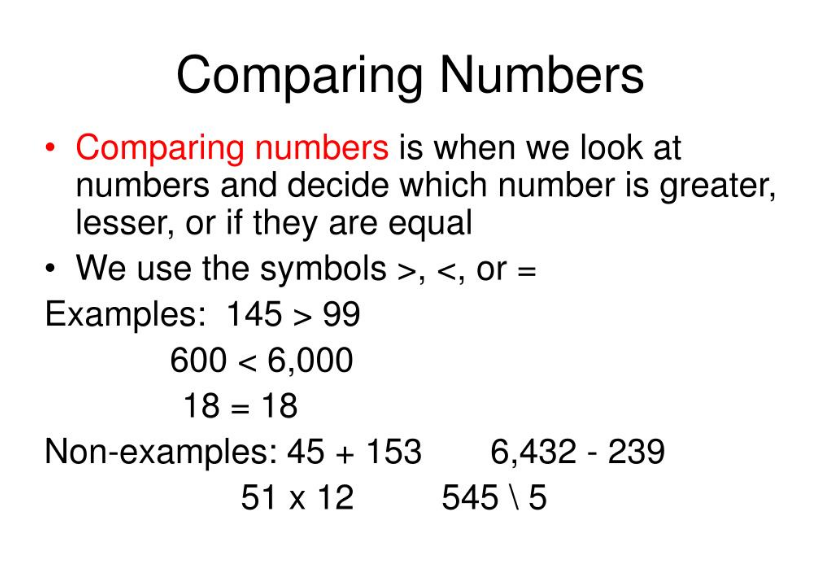Comparing numbers is a basic concept that we have learned in our primary classes. When we have two numbers or quantities to compare, then we use three basic symbols, they are:
- Equal to (=)
- Greater than symbol (>)
- Less than symbol (<)
Let us learn in this article, how to compare two numbers and what sign should be used to compare them.

Table of Contents
Less Than, Greater Than, Equal to
The three comparison symbols are less than (<), greater than (>) and equal to (=).
The “equal to” symbol is used to represent two equal numbers or quantities, such as:
3 = 3 or 10 – 7 = 3
The “greater than” symbol is used to show if a number is greater than the other number. For example,
10 > 3 [10 is greater than 3]
The “less than” symbol is used when a number or a quantity is less than the other. For example,
9 < 11 [9 is less than 11]
Use of Less than and Greater than
The less than and greater than symbols are used based on two numbers given to compare.
A bigger number greater than a smaller number is represented as:
Bigger Number > Smaller Number
A smaller number less than a greater number is represented as:
Smaller Number < Greater Number
Rules to Compare Numbers
There are certain rules, based on which it becomes easier to compare numbers. These rules are:
- Numbers with more digits
- Numbers starting with a larger digit
Rule 1: Number with more digits
When we compare numbers, then check if both the numbers are having the same number of digits or not. If a number has more digits, then it is greater than the other number.
Examples:
- 33 > 3
- 400 > 39
- 5555 > 555
- 10000 > 9999
Thus, from the above examples, we can reach the conclusion that:
- Two-digit numbers are greater than single-digit numbers
- Three-digit numbers are greater than two-digit numbers
- Four-digit numbers are greater than three-digit numbers
- Five-digit numbers are greater than four-digit numbers
And so on.
Rule 2: Numbers Starting with Greater Digit
This rule is applicable when two numbers are having the same number of digits. In such cases, we need to check the digit at the leftmost place, whichever is greater. Therefore, the number with a greater digit at the leftmost place of the number is greater than the other number.
Examples:
- 323>232 [323 is greater than 232]
- 343<434 [343 is less than 434]
Thus, in the above examples, we can see that, when we compare the two numbers, though the number of digits is the same, one number is greater than/less than the other number.
Condition: As we have discussed, if the left-most digit is greater, then the number is the greater one. But if the left-most digit of both the numbers is the same, then we need to check with the second left-most digit. Thus, in this way, we can find the greater or smaller number.
FAQs
In Mathematics, we use three basic signs to compare two numbers, they are:
Equal to (=)
Greater than (>)
Less than (<)
12 is greater than 8. 12 > 8
The number with more digits is the greater number. If two numbers are having the same number of digits, then compare the left-most digits of both numbers.
0.05 is greater than 0.01.
1/10 is equal to 0.1.
1/10 = 0.1
